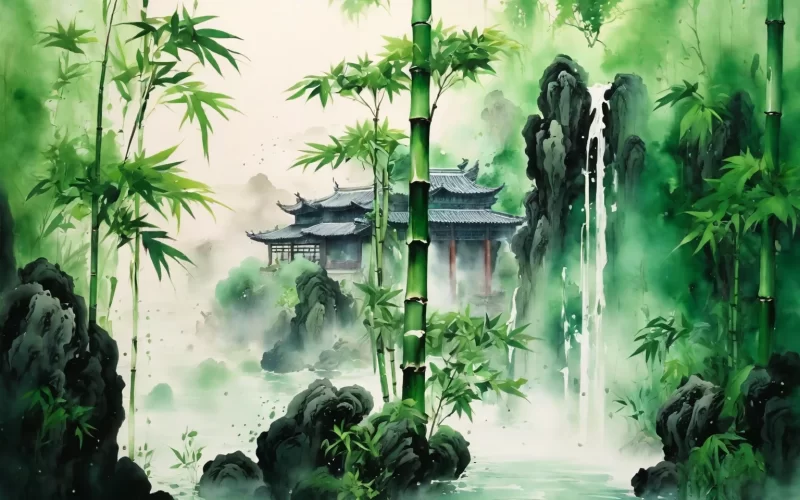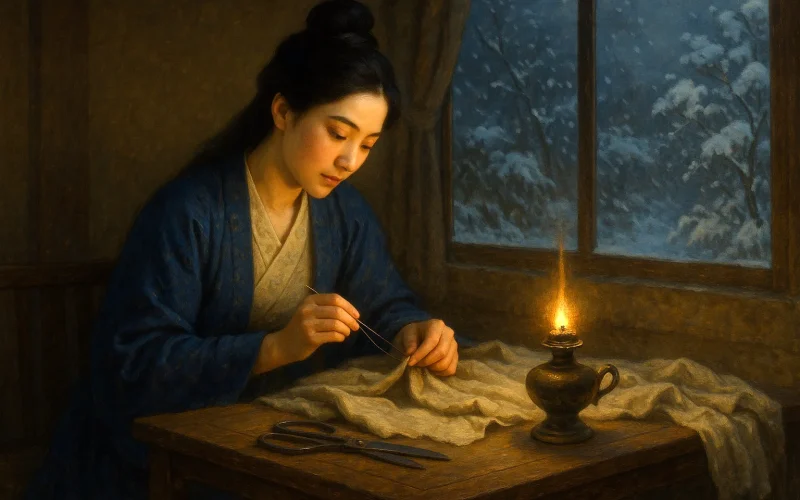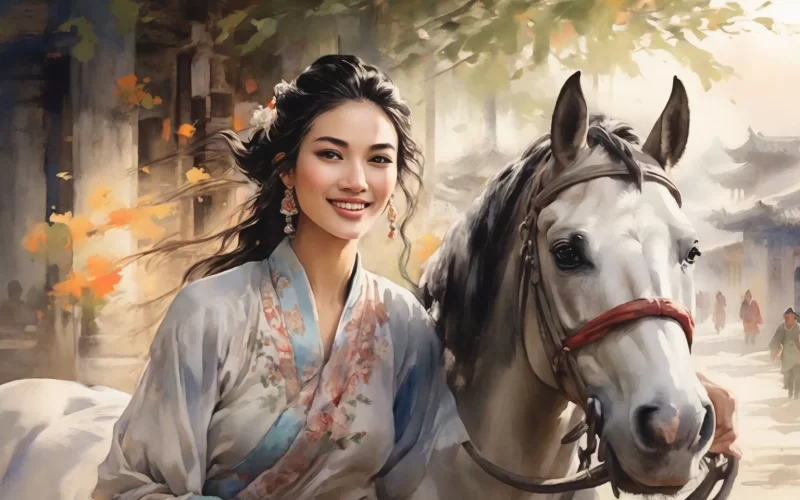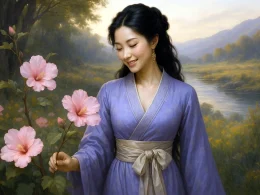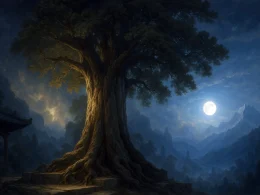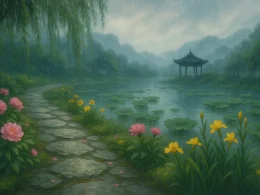A dog's barks blend with the sound of water;
Peach blossoms, thick with rain, glow deeply.
In the depth of the woods, deer are glimpsed at times;
By the creek at noon, no bell is heard.
Wild bamboos part the blue mist;
A flying spring hangs from the emerald peak.
No one knows where he has gone;
Wistful, I lean against two or three pines.
Original Poem
「访戴天山道士不遇」
李白
犬吠水声中,桃花带雨浓。
树深时见鹿,溪午不闻钟。
野竹分青霭,飞泉挂碧峰。
无人知所去,愁倚两三松。
Interpretation
Composed during Li Bai's early seclusion at Daming Temple on Mount Dai around age eighteen or nineteen, this poem centers on the theme of a "failed visit" as indicated in its title. Its brilliance, however, lies not in expressing disappointment directly, but in transforming an unsuccessful encounter into a spiritual journey into nature's heart. Through layered sensory progression, it traces a complete emotional arc from anticipation to poignant loss.
First Couplet: "犬吠水声中,桃花带雨浓。"
Quǎn fèi shuǐ shēng zhōng, táohuā dài yǔ nóng.
Dogs bark amid the water's murmur; Peach blossoms gleam, rain-drenched and deeper.
The opening engages hearing and sight to create an idyllic first impression. "Dogs bark" suggests human presence, sparking hope; "water's murmur" sets a serene tone. "Rain-drenched blossoms" depict a morning scene while hinting at Taoist immortal realms. Sight and sound blend—though no person appears, vitality permeates.
Second Couplet: "树深时见鹿,溪午不闻钟。"
Shù shēn shí jiàn lù, xī wǔ bù wén zhōng.
Deep in woods, deer sometimes appear; No noon bell rings along the stream.
This couplet marks the emotional turn. "Deer sometimes appear" emphasizes the deep quiet—deer, being shy, frequent visibility implies human absence. "No noon bell" delivers the first clear disappointment. The absent bell, typically sounded at midday, hints at the temple's emptiness. The poet conveys "no encounter" indirectly through this detail, achieving subtle power.
Third Couplet: "野竹分青霭,飞泉挂碧峰。"
Yě zhú fēn qīng ǎi, fēi quán guà bì fēng.
Wild bamboos part the blue mist's veil; Flying cascade hangs on jade peaks pale.
After accepting the "no encounter," the poet's gaze shifts fully to nature. This couplet unfolds like a majestic landscape scroll. "Part" lends dynamic force to bamboos, as if actively piercing the mist; "hangs" stills motion, fixing the waterfall as an eternal image. The majestic scenery praises the hermit's environment while revealing the poet's broad mind and transcendent yearning.
Fourth Couplet: "无人知所去,愁倚两三松。"
Wú rén zhī suǒ qù, chóu yǐ liǎng sān sōng.
None know where he's gone; Sorrow-leaning on pines, alone.
The conclusion returns to emotion, clarifying the "no encounter" theme. "None know" conveys post-visit茫然 and letdown. "Sorrow-leaning on pines" visualizes abstract melancholy as a lone figure leaning and gazing. The pines' purity and permanence contrast with life's chance encounters and lingering regret.
Holistic Appreciation
The poem's uniqueness lies in its masterful emotional rhythm. Like a four-act miniature drama: the first couplet enters with hope amid bright scenery—barking, murmuring streams, and rain-soaked blossoms create an idyllic impression; the second couplet turns—"deer in deep woods" contrasts with "no noon bell," the first disappointment; the third couplet peaks—releasing attachment to "no encounter," the poet embraces "bamboos parting mist, cascade hanging peaks," expanding the vision and revealing broad-minded transcendence; the finale lingers—"none know where" expresses茫然, concluding with the定格 image of "leaning on pines," leaving faint regret echoing. Through sensory shifts—from hearing water and barking to not hearing bells, to seeing deer, bamboos, cascade—the poet externalizes inner change from anticipation to loss, then release to wistfulness, achieving perfect scene-emotion unity.
Artistic Merits
- Deliberate Imagery Selection and Combination: Choosing "barking dogs," "murmuring streams," "peach blossoms," "deer," "bells," "bamboos," "mist," "cascade," "peaks," and "pines" creates a reclusive world far from worldly noise.
- Ultimate Motion-Quiet Contrast: The barking, water sounds, and flying cascade are dynamic yet accentuate the mountains' depth and stillness.
- Painterly Brushwork and Composition: Vivid color contrasts (peach red, bamboo green, mist blue, peak jade) and layered composition—foreground (blossoms, bamboos), midground (cascade), background (peaks)—create structured beauty.
- Subtle and Resonant Conclusion: Ending with the action of "sorrow-leaning" left the depth of melancholy unstated but felt, leaving readers infinite space for reflection.
Insights
This poem reveals a profound life philosophy: the meaning of pursuit lies not solely in achieving goals, but more importantly in the spiritual nourishment and expansion gained during the quest itself. Although Li Bai failed to meet the Taoist priest, he immersed himself completely in a landscape transcending worldly concerns—an experience forever imprinted on his life. It enlightens us that when expected outcomes remain unfulfilled on life's journey, we should not cling to disappointment over results. Instead, we ought to cherish and savor what we encounter and experience along the way. These experiences themselves often become our most valuable treasures, shaping our perspective and mental state.
About the poet

Li Bai (李白), 701 - 762 A.D., whose ancestral home was in Gansu, was preceded by Li Guang, a general of the Han Dynasty. Tang poetry is one of the brightest constellations in the history of Chinese literature, and one of the brightest stars is Li Bai.






